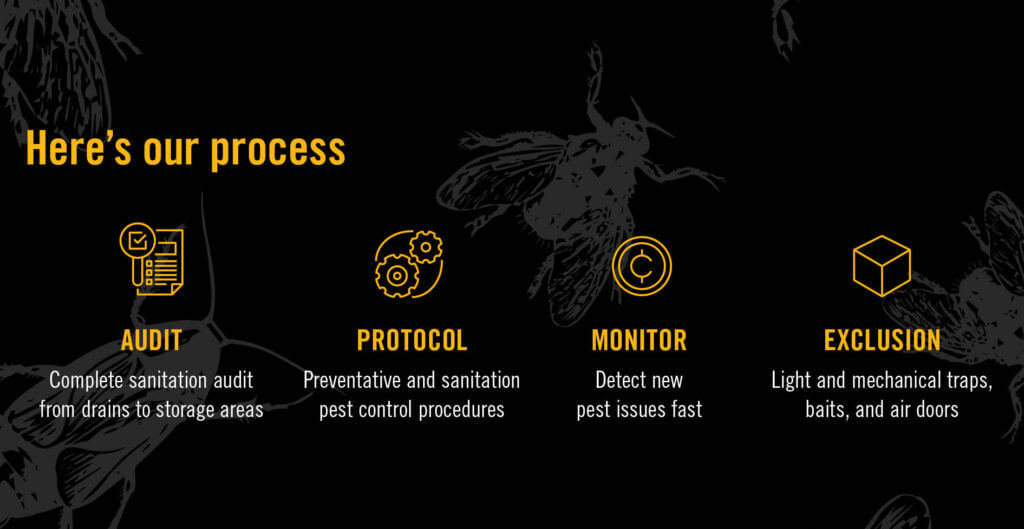The need for grab-and-go food in hotels and other foodservice settings has become a growing trend. Hotel guests desire, and in some instances even need, the ability to have quick options and truly go. And while convenience and freshness are the main priorities for grab-and-go meals – food safety, health considerations and pest infestations should also be top priorities.
Whether it’s pre-packed or self-serve, there are always risks of pests. Roaches, specifically, can be found anywhere there is food present. Once inside, roaches will feast on crumbs and food debris found near food prep areas and self-serve bars, food containers that aren’t sealed tightly or in places where trash has accumulated.
And aside from being unpleasant, roaches can contaminate any food supply from which they feed. Known to feed on feces, roaches also carry approximately 33 different types of bacteria, six types of parasitic worms and seven kinds of human pathogens. The bacteria, protozoans and viruses on their bodies can cause illnesses such as diarrhea, food poisoning, dysentery, typhoid fever and cholera. These nightcrawlers also leave behind a trail of excrement and skin casings that can cause allergic reactions.
Common Roach Species
There are three types of roaches your guests and staff are most likely to encounter in food areas:
- German roaches are the most likely type of roach to cause issues at your business and are considered the worst. Because of their rapid reproduction rate, populations can grow exponentially, and infestations can quickly become severe. They are light brown or tan with two black horizontal stripes located on the pronotum immediately behind the head. Their small size allows them to find more harborages than other roaches. German roaches lay 40 eggs at a time which mature in about two months. Feasting on starches, sweets, grease and meat products, German roaches are likely to be found near garbage containers, kitchen cabinets and under sinks near food sources.
- American roaches are reddish brown with a yellow band outlining their head. They easily pass under doors if the weather stripping is damaged. Windows and garages are also common entryways. Be sure to seal windows and weather strips. If they have already entered your hotel, your pest control provider should set up adequate amounts of bait around the area as they have large appetites, and this will help target the entire population. American roaches are fond of food under appliances, drains and kitchen cabinet and floors. Their droppings are often mistaken for mouse droppings. Mouse droppings have pointed ends and usually hair embedded in them, while American roach droppings have ridges on the side and are blunt on the ends.
- Oriental roaches are very dependent upon water and are often referred to as water bugs. While studies have shown that they can survive for up to a month without food, these insects cannot survive for more than two weeks without water. They are shiny black to dark reddish-brown color. The males have three-quarter length wings, while females have only large wing pads that cover the first couple of segments of the body. Their diet consists of almost anything, including decaying organic matter and trash.
Prevention tips
It’s best to implement an Integrated Pest Management (IPM) program to help eliminate conditions that attract roaches through proactive sanitation and maintenance. IPM is an ongoing process, and it emphasizes a partnership between your pest management provider and your staff. By implementing a strong IPM program and training staff, you’re ensuring that your guests don’t grab-and-go to another hotel.
- Make sure all outdoor trash bins have the lids tightly sealed. Remove garbage and spoiled foods from your premises. Keep nearby areas clean by regularly emptying trash and recycling bins.
- Don’t let waste, grass clippings or any organic material accumulate near your building.
- Clean drain pipes frequently with a bristle brush.
- Eliminate sources of pooling water to cut down on breeding sites.
- Apply caulk to cracks around windows and doors. Also ensure the screen fits properly.
- Clean up spills immediately.
- Be sure to take food out of cardboard boxes and store it in airtight containers.
- Sanitize storage and food preparation areas.
- Chemical and probiotic-type cleaners could be useful for certain equipment, cracks and crevices, or drain cleaning.
- Keep food, especially produce, covered and sealed.
- Clean behind appliances to eliminate breeding sites.
- Seal off small hiding spaces like wall cracks and holes in cabinets and furniture.
- Roaches are most active at night. While your doors are closed, roaches are wreaking havoc on your business. Roaches contaminate surfaces, infect food supplies and multiply. Thoroughly clean at night and properly store all food products.
When it comes to preventing pest issues – small or large – sanitation is always key. Schedule cleaning every seven days or so to disrupt developmental cycles.
You may have a roach infestation if you see:
- Foul odor given off by large infestations
- Skin casts and empty egg capsules in crevices close to the ground
- Roaches are nocturnal by nature and usually look for food at night. Spotting a roach during the day could indicate an infestation.
- Roach feces are the most common indicator of roach infestations. The excrement of small roaches looks like coffee grounds or black pepper. Larger roaches produce cylindrical droppings.
If you spot a roach near your grab-and-go area, reconsider do-it-yourself pest control techniques. A single intruder can quickly create a full-on infestation. Consider contacting a pest control expert to do the dirty work for you! Western Pest Services® offers thorough roach pest control — from uncovering infestations and identifying their sources to keeping your business pest free all year. Using IPM practices, we not only get rid of roaches — we teach you what steps to take to help ensure that they don’t return.
